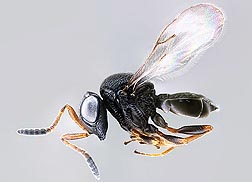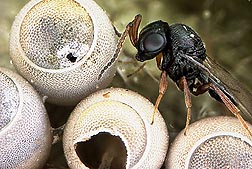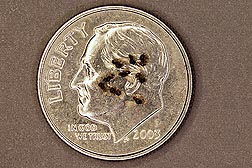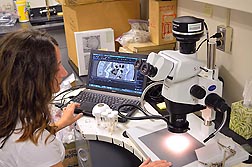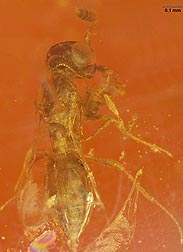Up Close and Personal With Tiny, Beneficial Wasps
|
|
Using specialized digital photography methods, Agricultural Research Service scientists and their collaborators are producing high-resolution images of members of the wasp superfamily Platygastroidea. Their goal is to improve the identification and taxonomic description of these tiny insects—including species with potential to biologically control important crop pests.
Of particular interest are 1- to 2-millimeter-long Trissolcus wasps that parasitize stink bug eggs. The larvae of such wasps hatch inside and devour the interior of the bug’s eggs, killing them in the process. Some species attack the eggs of the brown marmorated stink bug (BMSB), Halyomorpha halys, an invasive species from Asia that’s become established in 39 U.S. states and, in 2010, inflicted $37 million in damage to corn, soybean, grape, and other crops.
“One of the challenges of taxonomy for such small creatures is that taxonomists have had to rely on written descriptions and illustrations to understand what they have not seen firsthand,” explains Elijah Talamas, an entomologist with the ARS Systematic Entomology Laboratory (SEL) in Washington, D.C. “In some cases this has worked very well, and high-quality illustrations are extremely useful. However, illustrators simply cannot capture all of the detail that a photograph can.”
Toward that end, Talamas, together with ARS entomologist Matthew Buffington, has begun a project to photograph the collection of Platygastroidea wasp “holotypes” managed by colleagues at the Smithsonian Institution’s National Museum of Natural History (NMNH) in Washington, D.C. Holotypes are the reference specimens on which species names and descriptions are based.
|
|
It Starts With a Slice
The process begins with positioning a holotype specimen under a specialized camera with a single-column lens attached to a vertical joist and taking stacks of photographs throughout the depth of the specimen. Each photograph contains a small part of the insect in focus, due to the small depth of field at high magnification. These “slices” are then combined into a single, highly detailed, digital image magnified up to 100 times the specimen’s original size. The image is then uploaded to online databases, operated by Ohio State University (OSU) collaborator Norman Johnson, and linked to a description of the holotype and other information about it.
“Making the images freely available online makes it possible for anyone with an Internet connection to assess the morphology of the holotype specimens,” says Talamas. “Each specimen has a unique collecting unit identifier (CUID)—which allows a user to determine the specimen’s origin on a species-distribution map. Taxonomists can refer to a particular specimen via its CUID without ambiguity.”
|
|
Such capabilities are especially important in validating or correcting holotype names or descriptions that were made long ago. Talamas and colleagues published one such correction for T. halyomorphae, a promising biocontrol agent for BMSB, in the Journal of Hymenoptera Research. This species was described as new in 2009, but it was actually described more than 100 years ago by U.S. Department of Agriculture entomologist William Ashmead, and it is now called by its proper name, T. japonicus.
As an OSU graduate student under Johnson’s mentorship, Talamas produced over 3,000 digitized images of Platygastroidea wasps, and he has produced hundreds more since joining SEL in March 2013.
Searching for Biocontrols
The documentation of Trissolcus species provides invaluable taxonomic support to a team headed by Kim Hoelmer at the ARS Beneficial Insects Introduction Research Unit in Newark, Delaware. There, under quarantine conditions, Hoelmer’s group is examining the host specificity and safety of several Asian Trissolcus species with potential use in biocontrol-release programs against BMSB. (See “ARS Works Toward Control of Brown Marmorated Stink Bug,” Agricultural Research, January 2013, pp. 18-20).
Being able to tell the Asian species apart from one another and from native Trissolcus wasps will be critical on several fronts, including monitoring the purity of numerous research cultures, tracking the wasps’ spread from introduction sites, monitoring their behavior patterns in new environments, and gauging their effectiveness as biocontrol agents.
|
|
In a side project, using the NMNH collection, Talamas has begun photographing Platygastroidea wasp specimens entombed in amber dated 20-30 million years of age. There are many questions about the diversity and origins of the wasp superfamily, as well as its co-evolution with host insects, that are relevant to modern-day biocontrol pursuits.
“Right now, we don’t have enough specimens in amber to show the co-evolution of Platygastroidea with stink bug hosts,” says Talamas. “But we can begin to learn what groups were prone to extinction, which were more diversified, and conversely, which are present today but are not in the fossil record.”—By Jan Suszkiw, Agricultural Research Service Information Staff.
This research is part of Crop Protection and Quarantine, an ARS national program (#304) described at www.nps.ars.usda.gov.
Elijah Talamas is with the USDA-ARS Systematic Entomology Laboratory, National Museum of Natural History, 10th St. & Constitution Ave., N.W., Washington, DC 20560; (202) 633-0998.
"Up Close and Personal With Tiny, Beneficial Wasps" was published in the August 2014 issue of Agricultural Research magazine.







